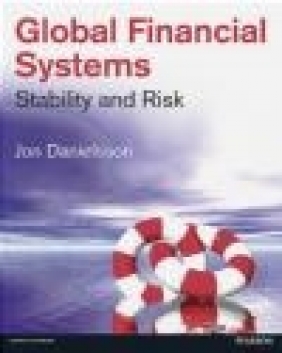Global Financial Systems
Jon Danielsson
Global Financial Systems
Jon Danielsson
- Producent: Pearson
- Rok produkcji: 2013
- ISBN: 9780273774662
- Ilość stron: 440
- Oprawa: Miękka
Niedostępna
Opis: Global Financial Systems - Jon Danielsson
Global Financial Systems is an innovative, interdisciplinary text that explores the 'why' behind global financial stability. Danielsson draws on economic theory, finance, mathematical modelling, risk theory, and policy to posit a coherent and current analysis of the global financial system. "Nicely and clearly written for an undergraduate audience...the book has a fresh perspective that will differentiate it from pre-crisis texts" Professor Goodhart, Professor Emeritus, London School of Economics "Global Financial Systems: Stability and Risk, looks to be an important book...it will appeal to those interested in regulation as well as those more on the regulatory side." Professor Caprio, William Brough Professor of Economics at Williams College and Chair, Center for Development Economics Jon Danielsson is Director of the Systemic Risk Centre, London School of Economics, and Reader in Finance Visit the author's personal website at http://www.globalfinancialsystems.org/ to read two online chapters covering the latest developments.Author's acknowledgements Publishers' acknowledgments Introduction 1 Systemic risk 1.1 Case study: the 1914 crisis 1.2 The concept of systemic risk 1.3 Who creates systemic risk? 1.4 Fundamental origins of systemic risk 1.5 Summary References 2 The Great Depression 1929-1933 2.1 Build-up to a depression 2.2 The Great Depression 2.3 Causes of the Great Depression 2.4 Implications for future policy 2.5 Summary 3 Endogenous risk 3.1 Millennium Bridge 3.2 Dual role of prices 3.3 Risk 3.4 Dynamic trading strategies 3.5 Actual and perceived risk and bubbles 3.6 The LTCM crisis of 1998 3.7 Conclusion 4 Liquidity 4.1 The liquidity crisis of 1998 4.2 What is liquidity? 4.3 Liquidity models 4.4 Policy implications 4.5 Summary References 5 The central bank 5.1 The origins of central banks 5.2 Banking supervision 5.3 Monetary policy 5.4 Financial stability 5.5 Bailing out governments 5.6 Challenges for central banking 5.7 Summary Appendix: central bank interest rate References 6 The Asian Crisis of 1997 and the IMF 6.1 Building up to a crisis 6.2 The crisis in individual countries 6.2.3 South Korea 6.3 Reasons for the crisis 6.4 Policy options for the crisis countries 6.5 Role of the IMF 6.6 Wider lessons 6.7 Summary References 7 Banking crises 7.1 Money and early banking 7.2 Moral hazard 7.3 Costs of banking crises 7.4 Causes of banking crises 7.5 Bank and banking system failures 7.6 Summary References 8 Bank runs and deposit insurance 8.1 Bank runs and crises 8.2 Modelling deposit insurance 8.3 Pros and cons of deposit insurance 8.4 Summary References 9 Trading and Speculation 9.1 Trading scandals and abuse 9.2 Trading and risk 9.3 Trading activities 9.4 Policy issues 9.5 Summary References Appendix: basic terminology of trading 10 Credit markets 10.1 Market for credit 10.2 Credit rating agencies 10.3 Credit models 10.4 Margins, haircuts and mark-to-market 10.5 Securitisation 10.6 Summary 11 Currency markets 11.1 Fixed or floating 11.2 Foreign exchange interventions 11.2.1 Sterilisation 11.3 Capital controls 11.4 Exchange rate regimes 11.5 Perils of overvaluation 11.6 Undervaluation and 'currency wars' 11.7 Reserve currency 11.8 Summary Appendix: exchange rate regimes References 12 Currency crisis models 12.1 First-generation models 12.2 The Argentinean crisis 12.3 Second-generation models 12.4 European crisis 1992-1993 12.5 Global games currency crisis model 12.6 Summary References 13 Financial regulations 13.1 Banking regulations 13.2 Bank capital 13.3 International financial regulations: Basel 13.4 Summary Appendix: Value-at-Risk References 14 Bailouts 14.1 Successful and unsuccessful bailouts 14.2 The historical origins of lending of last resort (LOLR) 14.3 What are bailouts? 14.4 Alternatives to bailouts 14.5 Bailouts in the crisis starting in 2007 14.6 Bailouts, moral hazard and politics 14.7 Model of asset bubbles 14.8 Summary References 15 Dangerous financial instruments 15.1 Complexity kills 15.2 Derivatives 15.3 Credit default swaps 15.4 Collateralised debt obligations 15.5 Summary Appendix A: mechanics of CDSs Appendix B: CDO calculations References 16 Failures in risk management and regulations before the crisis 16.1 Regulatory failures 16.2 Capital and the crisis 16.3 Summary References 17 The ongoing crisis: 2007-2009 phase 17.1 Build-up to a crisis 17.2 Hidden and ignored risk 17.3 The changing nature of banking 17.4 Crisis 2007-2008 17.5 Was it a subprime crisis? 17.6 Policy response 17.7 Summary References 18 Ongoing developments in financial regulation 18.1 New and changed institutions 18.2 Basel III 18.3 Liquidity 18.4 How much capital? 18.5 Recovery and resolution 18.6 What about too big to fail? 18.7 Summary References 19 Sovereign debt crises 19.1 Newfoundland 19.2 Sovereign debt 19.3 Enforcement 19.3.1 History lessons 19.4 Background to the European sovereign debt crisis 19.5 Summary References Glossary Bibliography Index
Producent:
GPSR Pearson Central Europe Sp. z o.o.
ul. Szamocka 8
01-748 Warszawa (PL)
tel: 459 596 060
email: [email protected]
Szczegóły: Global Financial Systems - Jon Danielsson
Tytuł: Global Financial Systems
Autor: Jon Danielsson
Producent: Pearson
ISBN: 9780273774662
Rok produkcji: 2013
Ilość stron: 440
Oprawa: Miękka
Waga: 0.93 kg





















